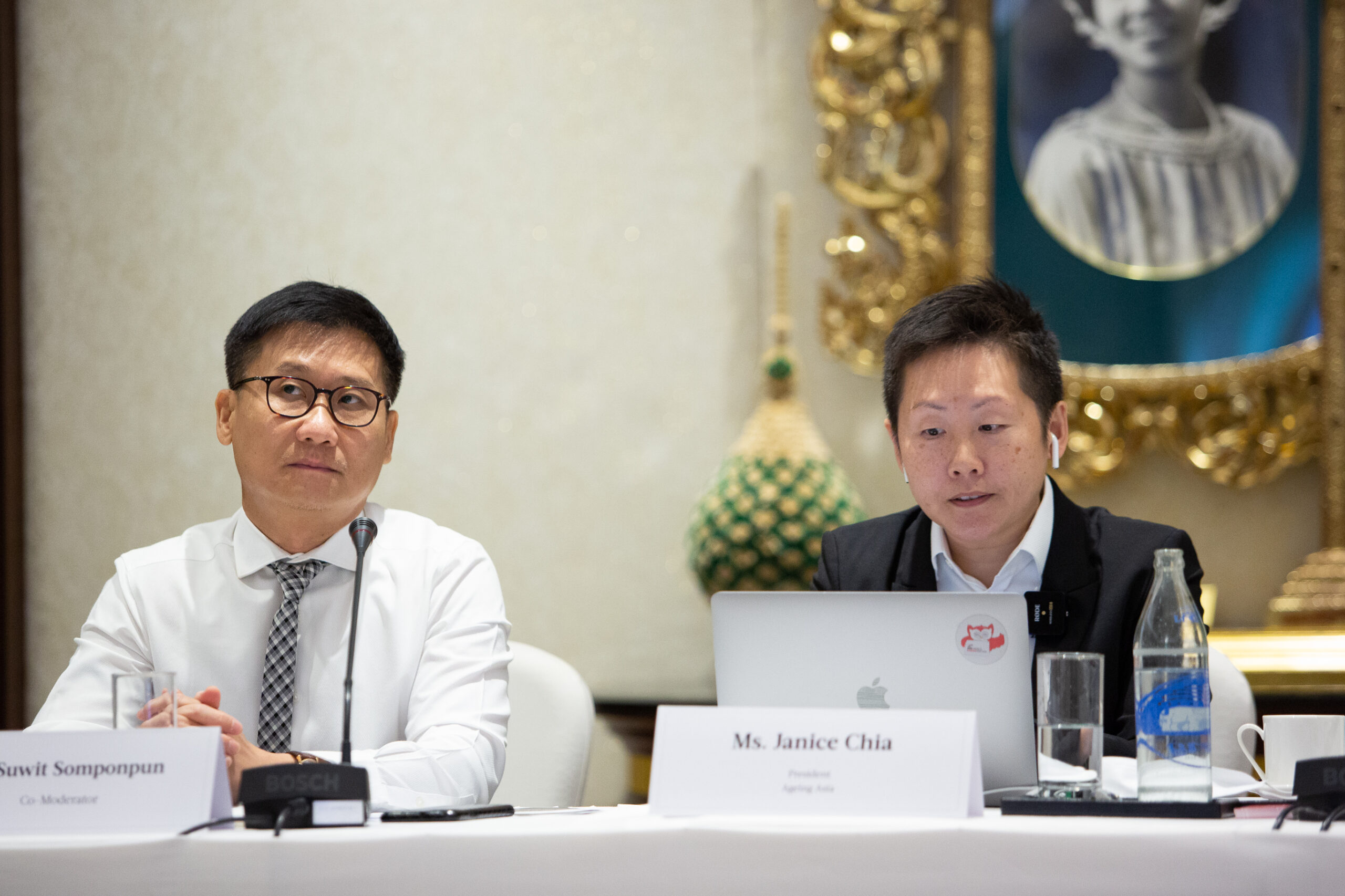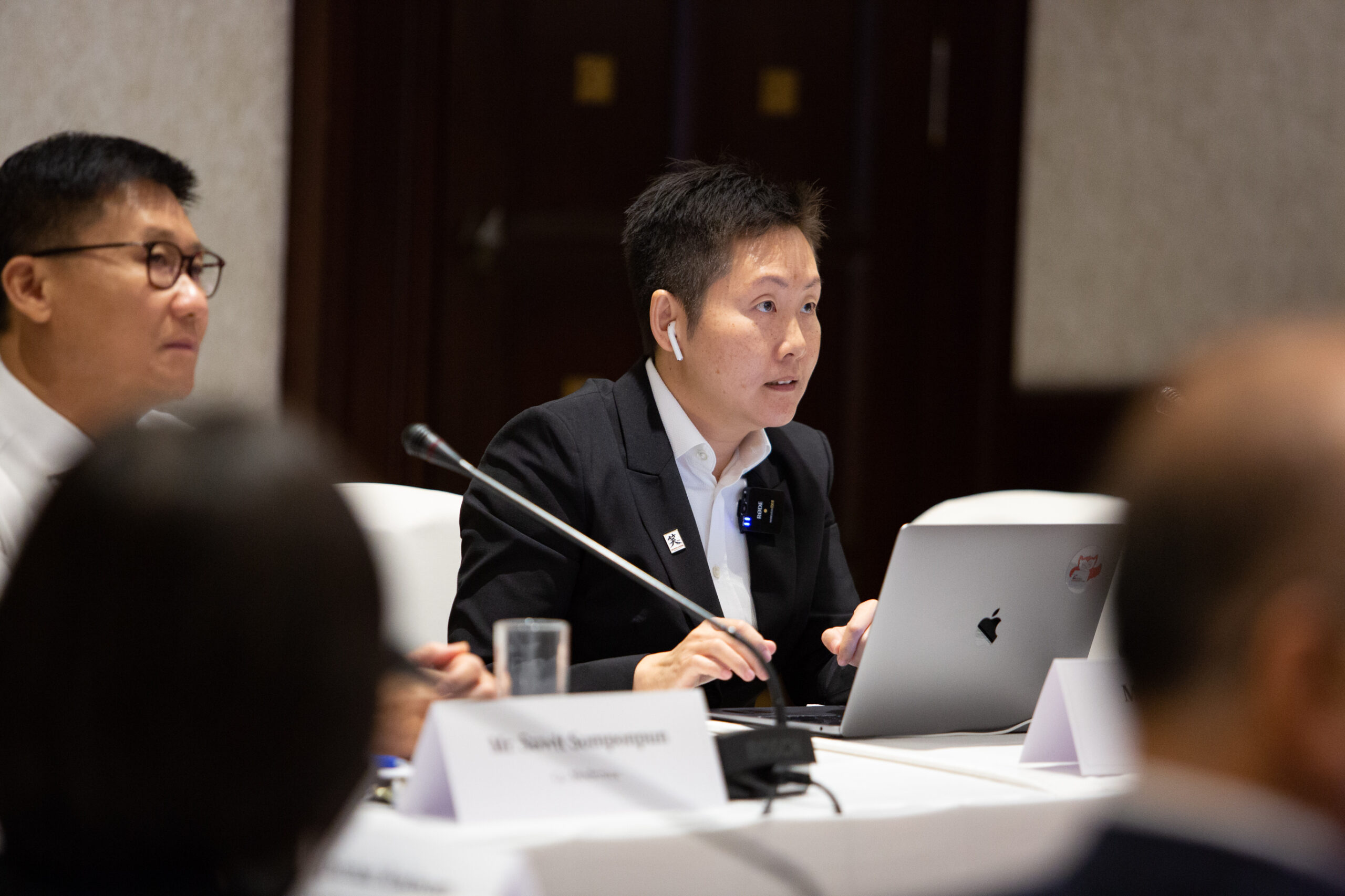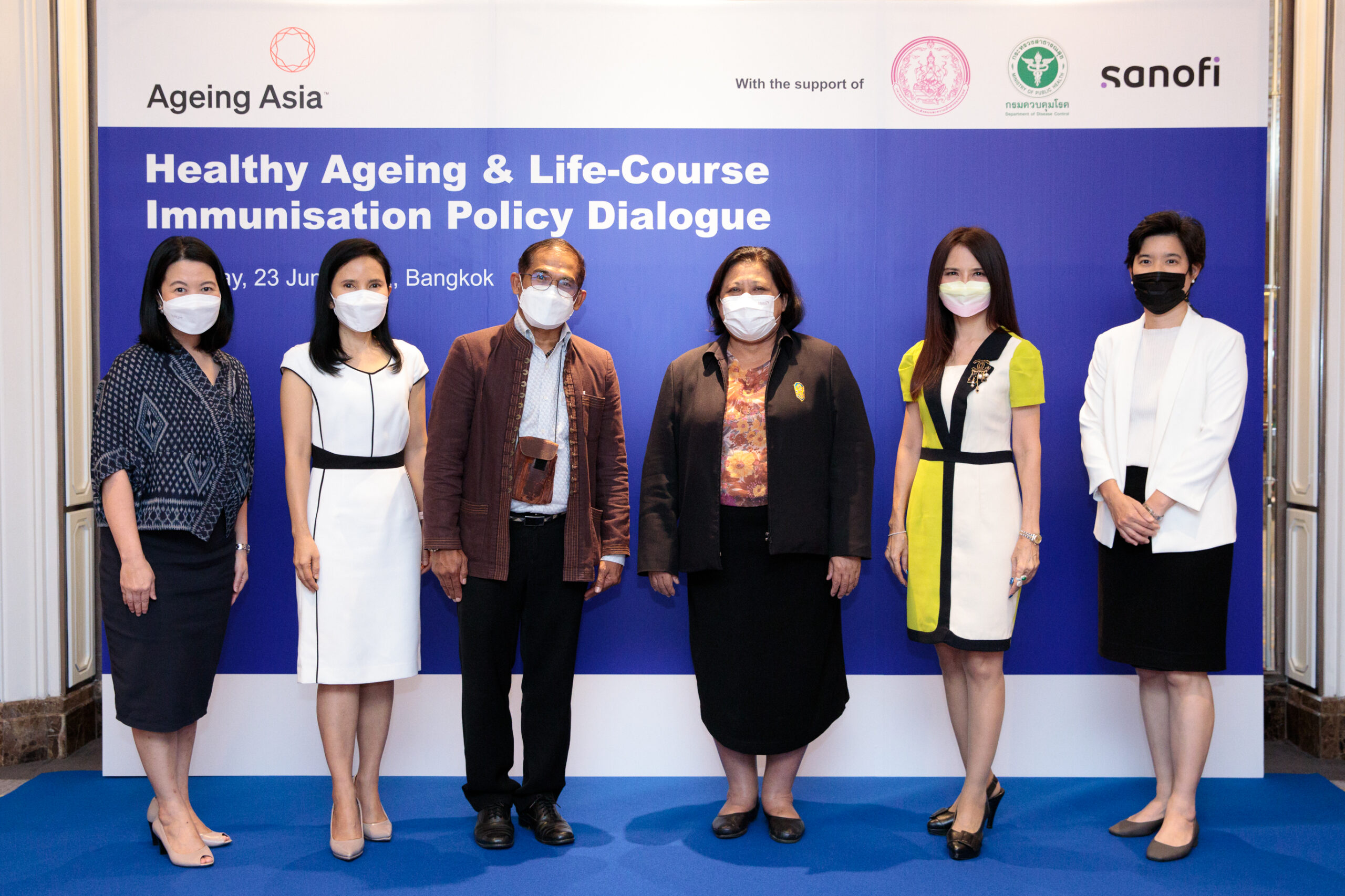
Summary
- Against the backdrop of an ageing population, Thailand has been making great strides in recognising the challenges and enacting policy changes that underscore the health and wellbeing of the elderly, such as implementing life-course
- To discuss how public and private sector can continue to collaborate to provide better protection to the elderly through life- course immunisation, a roundtable was held with leading experts from various sectors, including policy makers, academia, healthy ageing advocates and healthcare
- Participants discussed the barriers faced to protect vulnerable populations, which include low awareness of infectious diseases and importance of vaccination among both the public and healthcare professionals, as well as the accessibility of
- Participants also discussed the need for integrated effort across ministries and via private-public partnerships to raise awareness of life-course immunisation, improve access and infrastructure and drive action to increase the uptake of vaccines.
Introduction
All societies in the world are in the midst of what the United Nations terms as a “longevity revolution”, where by 2050, one in six people in the world will be over the age of 65, up from one in 11 in 2019. This reality is reflected in Asia too, where more than 14% of the population is aged 65 years and older. Asia is also projected to house 62% of the elderly population in 2050, which makes the region the oldest in the world.
Zooming in on Thailand, the country is one of the fastest ageing countries in the world. It is expected to become an aged society, with 30%, or 19.5 million, of its population aged 65 and above by 2050. Thailand’s ageing population increase – from 13% in 2020 to 30% in 2050 – represents the fifth largest percentage point increase globally. Thailand’s support ratio (ratio of persons aged 20–64 years per person aged 65 or over) is expected to halve from 6.2 people for every older adult in 2015 to 3.1 people for every older adult in 2030.
While people are living longer – life expectancy for Thais is 77 years – they may not necessarily be living healthier. A World Health Organization report shows that Thais will only on average spend 68.3 years of their lives being healthy – this means that Thais lose about a decade of their lives if there are no healthy living interventions.
Recognising the challenges of this demographic shift globally, the United Nations has dedicated the years 2021–2030 as the Decade of Healthy Ageing, to improve the lives of older people, their families and communities. Complementing this strategy is the World Health Organization’s Immunisation Agenda 2030, which recognises that vaccination can save millions of lives. Immunisation is a crucial pillar to ensure healthy ageing. By increasing the uptake of vaccination globally, individuals of all ages, including the elderly, will be able to enjoy longer and healthier lives.
Thailand has been making great strides in recognising the ageing challenge and the urgency of ensuring populations age healthily, with policy changes at both national and local levels, including the provision of selected adult vaccines to older adults.
However, infectious diseases among older adults continue to be an important challenge that needs urgent attention. For example, the incidence of influenza for people aged 65 years and above is 162.41 per 100,000. Additionally, the COVID-19 pandemic disproportionately affected the elderly in Southeast Asia, including Thailand. During the pandemic, ageing populations have been highlighted as a specific risk group. In Thailand, as of 26 April 2020, 11% of all patients are aged 60 and above, and death rates among patients over 60 years is 6.4%, versus 0.6% for people in the 30s and 1.9% for people in the 40s. COVID-19 reduces the numbers and functional competence of certain types of immune cells in the blood. Coupled with the progressive decline of the immune system’s ability to fight infections caused by ageing (immunosenescence), the urgent need to protect the elderly against infectious diseases including influenza cannot be understated.
To discuss how public and private sector can continue to collaborate to provide better protection to older adults, a roundtable was held in Thailand on 23rd June 2022 with leading experts from various sectors, including policy makers, academia, healthy ageing advocates and healthcare providers. This roundtable is one of a series of policy dialogues being organised across Southeast Asia by Ageing Asia, and supported by Sanofi, to align on progressive policy actions to improve the access to and uptake of life-course immunisation in-country.
This roundtable series builds on the insights in the 2021 report published by the EU-ASEAN Business Council, KPMG and Sanofi, titled ‘The Decade of Healthy Ageing in ASEAN: Role of Life-course Immunisation’ in 2021, which explored the barriers and solutions to life-course immunisation access and uptake.
The insights and solutions gathered during the 2022 roundtable have been summarised in this report, with no direct attribution to any participants. However, contributing participants and organisations have been credited to these highlights.
We thank all roundtable participants for their valuable contributions.

Life-course immunisation landscape in Thailand
The 2012–2016 National Economic and Social Development Plan and, more recently, the 2017–2036 National Strategy, underscore the welfare of older persons as a government priority. At the heart of Thailand’s approach is universal health insurance, which covers free medical check-ups for chronic conditions such as high blood pressure, diabetes, certain cancers like cervical cancer and dementia, as well as vaccinations against influenza for the elderly.
The threat of infectious diseases, especially to vulnerable populations including the elderly, cannot be underestimated. Our immune system starts to decline as we age, increasing our risk of infectious diseases, such as influenza. For example, influenza leads to an estimated 6.1 deaths per 100,000 persons annually in Thailand. Out of this total, the elderly constitutes 83% of deaths. Overall, seasonal influenza is estimated to cost Thailand up to USD 83.6 million annually in direct medical, non-medical and indirect costs from productivity losses.
Life-course immunisation can protect the elderly in Thailand from influenza and other infectious diseases, minimising the health and economic burden of influenza and other infectious diseases and their associated health complications. As evidenced by the NICE report commissioned by Public Health England, interventions to increase Vaccine Coverage Rate (VCR) levels are cost effective up to an investment up to £4.50 per person if there is an incremental impact of 5% in VCR.
Since 2008, high-risk groups in Thailand, which includes older adults aged 65 and above, are able to obtain free influenza vaccines through the Expanded Programme on Immunisation (EPI), which is covered under the budget of the Universal Health Coverage scheme.
Despite the obvious benefits of vaccination as well as Thailand’s recognition of the value of adult immunisation, Thailand’s immunisation rate remains low, with only 20% of the elderly aged 65 and above receiving vaccinations against influenza in 2012. While the immunisation rate is higher compared to other countries in ASEAN, it is far below the target set by the World Health Organisation at 75%. There is a need to explore more and better ways to protect vulnerable groups, especially the elderly against infectious diseases and their complications, towards a healthy ageing population. In addition, there is an opportunity for Thailand to lead as an example in the region in terms of enabling a healthy and productive population through better preventative health techniques.
What are the barriers faced to protect vulnerable populations, including the elderly in Thailand?
Awareness of life-course immunisation, the impact of infectious diseases and vaccine availability
Low awareness of infectious diseases and misconceptions about vaccines
Awareness of life-course immunisation and the impact of infectious diseases remains low. The elderly population depend on younger members of their family and caregivers for support and information on vaccinations, thus they do not fully understand the value of life-course immunisation.
Taking influenza as an example. Despite 77% of elderly aged 60 years and above reporting to have received information on influenza infection, only 30% had high levels of knowledge about the disease, with 38.7% and 31.1% of elderly having moderate and low levels of knowledge, respectively. Misconceptions about influenza include the belief that influenza is the same as the common cold.
Against the backdrop of the COVID-19 pandemic, people also have the misconception that they do not need to get influenza vaccines because they have taken the COVID-19 vaccine.
Because influenza and COVID-19 are different diseases, both vaccines are needed to be protected from each disease.
“People believe that flu (influenza) is the same as the common cold, but this is wrong. Flu may cause death, therefore educating people about flu is important.”
Tawee Chotpitayasunondh – Influenza Foundation (Thailand)
Low awareness and advocacy among healthcare professionals
Low awareness of influenza extends to healthcare professionals (HCPs). According to a study, only 57.2% of HCPs were aware of the health benefits of the influenza vaccine. Not only are HCPs unaware of the benefits of the influenza vaccine, but their attitudes towards immunisation can also determine if they will recommend vaccines. For example, more than 40% of HCPs believe that without underlying disease or co-morbidity, influenza vaccines were unnecessary. Some attendees also had the perception that there was a need to build more trust between healthcare providers, especially between younger doctors and older adults, for Thais to take the advice of their healthcare providers to get vaccinated.
In the urban areas, the limited network of healthcare volunteers advocating for vaccinations also means that efforts to further encourage the uptake of vaccinations in the elderly population may be hampered.
Low awareness of vaccine availability
In addition, people are not aware that free influenza vaccines are available to them. The national influenza vaccine campaign in Thailand begins around May each year. Annually, about four million doses of the vaccine are available free of charge for about four months during the campaign to all recommended at-risk groups. As people are not aware that vaccines are provided for free, the uptake of vaccines among these at-risk groups remains low.
Accessibility of vaccines
Insufficient doses to fully cover high-risk populations
Free influenza vaccinations are available to high-risk populations under the EPI, including the elderly, healthcare workers, pregnant women, infants and adults with comorbidities. However, more can be done to ensure that more of the vulnerable population are covered under this scheme. Currently, 6.4 million doses of the influenza vaccine are available in the EPI (as of March 2021) but there are 11.5 million people listed in the high-risk populations, out of which, 7.5 million are the elderly. There are simply not enough vaccine doses for everyone in the high-risk population.
Limited accessibility at healthcare facilities
While vaccines are broadly available to vulnerable populations, some of them, especially the elderly, may not find it easy to go to healthcare facilities to get vaccines. In addition, because the free vaccines are only available from May to August each year, patients may face long queues, and this may discourage them from receiving the vaccine.
Caregivers also may not have the time to take their guardians to the healthcare facilities.
Logistics and cold-chain management infrastructure
Logistics, especially the safe storage of vaccines, can also be a barrier, especially in rural areas. Influenza vaccines require refrigeration. However, some district hospitals and community clinics do not have the infrastructure needed to safely transport and store vaccines or face unreliable electricity supply. This means that vaccines go to waste if they are transported or stored inappropriately. Furthermore, insufficient manpower to deploy the vaccines during the flu season make the vaccine inaccessible to those who need it.
What can be done to better protect vulnerable populations, especially the elderly in Thailand?
Integrated effort across ministries and via private-public partnerships are needed to better protect the vulnerable population and the elderly. The participants discussed solutions that can be grouped into three categories – Awareness, Access and Action.
Awareness: Raising awareness of life-course immunisation
Educate the public and patients
Because of the overall low awareness of vaccines and the impact of infectious diseases, consistent and regular communication to educate the public is crucial, with a focus on addressing the misconceptions about the disease, the severe impact of influenza, the importance of vaccination and the availability of vaccines.
Leverage HCPs as advocates
Communication should be extended to HCPs. Studies have shown that patients’ acceptance and uptake of vaccinations, compliance with vaccination schedules and reduction of hesitancy/aversion is affected by the attitude and use of vaccinations by HCPs. In Thailand, HCPs are often held in high regard, with close to 90% of Thais trusting a doctor or nurse for medical advice. Therefore, communication targeted at HCPs can help inform them so that they become advocates and recommend vaccines to their patients.
In addition to doctors, other frontline healthcare workers such as healthcare volunteers should not neglected as an avenue to educate patients about the benefits of vaccination, the risks of not getting vaccinated and the impact of infectious diseases. To encourage greater ownership of vaccine recommendations by healthcare workers across all healthcare settings, frameworks and guidelines for healthcare workers to do so should be encouraged. For example, a vaccine coverage rate target can be set for hospitals and incentives given to practitioners to achieve those targets. This has proven to be effective, as seen from the United Kingdom. Financial incentives offered to general practitioners helped increased the VCR from 24% to 46% in two years.
Access: Improving access and infrastructure
Increasing the supply of vaccines
It is only in recent years that the focus to broadly vaccinate against diseases such as influenza, pneumococcal, tetanus and hepatitis was extended to the elderly population.
In addition to newly established funding to support the procurement of the needed supply, negotiating long-term contract with vaccine manufacturers can help increase the supply of vaccines in the national immunisation programme.
Tap on technology to educate and monitor vaccine uptake
In the past two years, Thailand has invested in technology during the COVID-19 pandemic to provide knowledge about and to monitor the spread of the virus. This includes the Mor Prom app, which allows residents to access vaccination services, including vaccine reservation and tracking, as well as updated information on COVID-19. Similar technology and apps can be repurposed to track the uptake of other vaccination while technologies spurred by the pandemic such as telemedicine can help improve access by connecting patient pathways better.
“During the COVID-19 pandemic, Thailand has invested in technology and telemedicine. We can use technology to
educate about influenza and close the gaps.”
Kannikar Bunteongjit – Senior Citizens Council of Thailand
Improve cold-chain management infrastructure
Another aspect of access to vaccines is ensuring that the appropriate cold-chain management infrastructure is in place to transport and store vaccines, especially at a district level and in rural areas. Improving vaccine storage infrastructure will facilitate vaccination in last mile areas in Thailand.
In addition, vaccination sites across the country can be expanded to include pharmacies, long-term care facilities, nursing homes, workplaces and via home visits. This includes coordination and collaboration between healthcare workers, who are approved to administer vaccination, to support on- site vaccinations at locations beyond healthcare facilities.
Action: Driving action and uptake of vaccines
Expand vaccine coverage to more people
Thailand currently provides influenza vaccines to seven vulnerable groups, including the elderly aged 65 years and above. Current healthcare policies can be changed to extend vaccine coverage to more people, such as adults who are between 60 to 64 years old, to ensure that more at-risk groups are covered. To do so, considerations such as reimbursement for people beyond these vulnerable groups is a crucial step to encourage vaccine uptake.
“Influenza vaccines are currently provided to seven at-risk groups. If we want to increase vaccine uptake among these
at-risk groups and beyond, a coordinated approach among both the public and private sector is needed to understand how we can progress.”
Prasobsri Ungthavorn – The Royal College Paediatricians of Thailand
Encourage ground-up efforts
Leverage health volunteers and community leaders as important influencers and advocates to drive vaccine uptake in their communities, especially in rural areas. In addition, tap on caregivers and children to encourage their older guardians and parents to get the vaccines.
Review and update influenza protection guidelines
To provide the best possible protection for the vulnerable groups and elderly, review and update the national vaccination guidelines, such as the influenza protection guidelines, to include improved vaccines that offer better protection for vulnerable populations such as the elderly. This could include the use of quadrivalent influenza vaccines (QIV) instead of trivalent vaccines (TIV). TIVs contain two influenza A antigens and one B antigen while QIVs contain an additional B antigen, making QIVs more protective against influenza.
Improved vaccines also include high-dose inactivated vaccines, available in a QIV formulation. As they have higher efficacy against the standard-dose vaccine against respiratory- and pneumonia-related hospital admissions, they should be included in the EPI for better protection and to save more lives.




